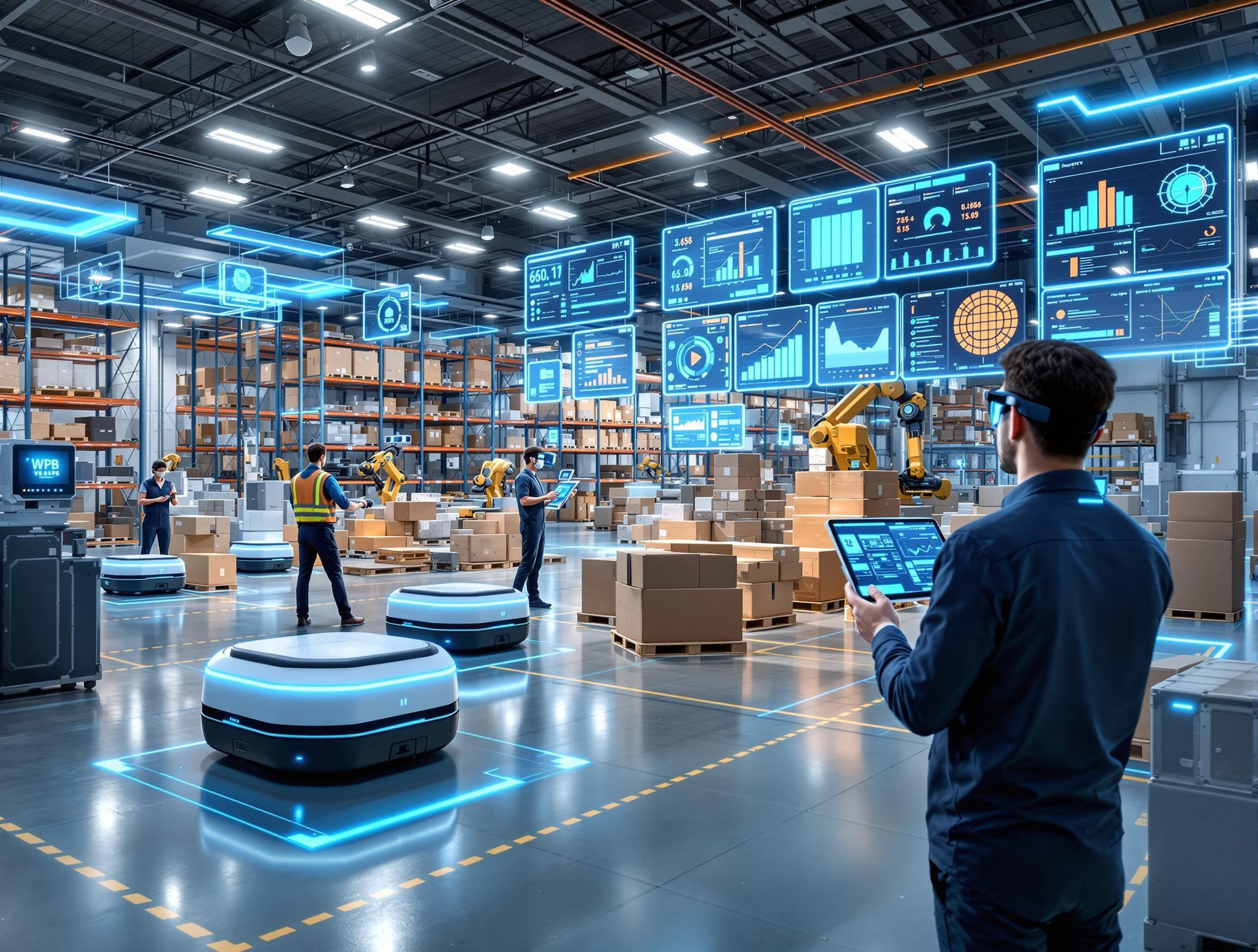In 2025, warehouse operations across the UK are undergoing a major transformation. With the rise of modern warehouse technology, businesses are increasingly turning to robotics, Warehouse Management Systems (WMS), and Augmented Reality (AR) to improve productivity, reduce costs, and meet the growing demands of e-commerce. These advancements are not just trends; they are reshaping the entire logistics industry and setting new benchmarks for efficiency and accuracy.
Latest Robotics Innovations in UK Warehouses
One of the most exciting developments in warehouse operations is the adoption of robotics. From robotic arms used for sorting packages to Autonomous Mobile Robots (AMRs) that navigate through warehouse aisles, UK warehouses are becoming smarter and faster.
AMRs use sensors and AI to move goods with precision, reducing the need for human intervention in repetitive tasks. Cobots, or collaborative robots, are another innovation. These robots work alongside human employees, enhancing productivity while improving workplace safety.
Companies like Ocado and Amazon have already implemented warehouse robots that significantly boost order processing speeds. This not only increases output but also ensures more accurate and timely deliveries.
Streamlining Operations with WMS (Warehouse Management Systems)
A Warehouse Management System (WMS) is essential for businesses that want to stay competitive in today’s digital age. These software systems manage inventory, track stock movement, and provide real-time data on warehouse activities.
Modern WMS platforms are cloud-based, which means they can be accessed from any device with internet connectivity. They integrate seamlessly with other supply chain tools like ERP (Enterprise Resource Planning) systems and transportation management systems.
In the UK, logistics firms are adopting WMS to:
- Minimise stock discrepancies
- Optimise storage space
- Enhance inventory accuracy
- Reduce order fulfilment times
The result? Lower operational costs and improved customer satisfaction.
The Role of AR in Warehouse Efficiency
Augmented Reality (AR) is another cutting-edge tool making waves in the warehouse industry. Using AR-enabled devices like smart glasses, workers can see digital overlays that guide them through picking, packing, and restocking tasks.
For instance, AR can display the shortest route to an item’s location or provide real-time inventory information. This significantly reduces picking errors and improves overall efficiency.
Some warehouses use AR for training purposes. Instead of spending days shadowing experienced staff, new employees can be trained through interactive AR simulations that mirror real-life scenarios.
Cost-Saving and Productivity Benefits
The integration of robotics, WMS, and AR brings significant financial advantages to UK warehouses. Automation reduces the need for manual labour, lowering payroll costs. At the same time, technology improves accuracy, reducing errors that can lead to costly returns and customer complaints.
By investing in modern warehouse technology, companies benefit from:
- Faster order processing
- Fewer workplace accidents
- Higher throughput
- Better inventory management
According to a recent report by the UK Warehousing Association, businesses that implemented automation saw up to a 30% increase in operational efficiency.
Challenges and Limitations of Automation
Despite the benefits, automation in warehouse operations comes with its own set of challenges. The initial investment for robotics or AR systems can be substantial. Smaller businesses may find it difficult to justify the cost without a clear short-term ROI.
There are also technical limitations. Not all warehouse layouts are suitable for automation, and integrating new systems with legacy platforms can be complex. Additionally, workforce resistance to change and lack of training can delay implementation.
To overcome these barriers, companies must conduct feasibility studies and invest in proper training and change management programmes.
Reskilling Warehouse Staff for Tech Adoption
As automation replaces some manual tasks, new roles are emerging that require technical skills. Warehouse workers now need to understand how to operate and troubleshoot robotic systems or manage software platforms like WMS.
UK companies are increasingly offering reskilling opportunities to help their workforce adapt. Government-funded schemes and vocational training programmes are also available to bridge the digital skills gap.
Upskilling is not just beneficial for employees; it ensures that companies retain experienced workers who can effectively manage modern systems.
Read more: UK Business Development: Reskilling & Upskilling Solutions
Real-Time Data and IoT Integration
The Internet of Things (IoT) plays a key role in modern warehouse technology. Sensors installed on shelves, forklifts, and conveyor belts collect real-time data on movement, temperature, and stock levels.
When integrated with WMS, this data helps:
- Predict stock shortages
- Schedule equipment maintenance
- Track order progress
IoT-enabled warehouses offer superior visibility and control, allowing businesses to make data-driven decisions that enhance performance and reduce waste.
Sustainability Through Smart Warehouse Operations
Sustainability is a top priority for UK businesses. Automation technologies contribute to greener operations by reducing energy consumption and waste.
Robots optimise movement paths, cutting down unnecessary travel and lowering emissions. Smart lighting and temperature controls managed through IoT also contribute to energy savings.
Furthermore, digital inventory tracking minimises overstocking and expired goods, reducing landfill waste.
UK Warehouse Success Stories
Several UK-based companies are leading the way in warehouse automation. Ocado, a pioneer in online grocery fulfilment, has developed a robotic system that can process 65,000 orders per week.
DHL Supply Chain has also invested in robotics and AR for its UK warehouses, reporting a 25% increase in picking efficiency.
These success stories show that investing in technology is not only viable but necessary for staying ahead in a competitive market.
Read more: How to Create a Personal Brand for Success?
Career Opportunities in Tech-Driven Warehousing
With the rise of automation, there’s a growing demand for skilled professionals in logistics technology. Roles such as WMS analysts, robotics maintenance technicians, and AR content developers are now in high demand.
Fresh graduates and job seekers should consider pursuing careers in tech-driven warehousing. Certifications in data analytics, software integration, and robotics programming can give candidates a competitive edge.
Conclusion: Preparing for the Future of Warehousing
Modern warehouse technology is transforming how goods are stored, moved, and delivered in the UK. Robotics, WMS, and AR are not just innovations; they are strategic tools for achieving business growth and operational excellence.
By embracing these technologies, companies can stay competitive, reduce costs, and meet the evolving expectations of consumers. The future of warehousing in the UK is digital, and those who invest today will lead tomorrow.
Stepping into smart logistics? Build a personal brand that showcases your expertise in modern warehouse operations—from robotics to WMS and AR! 🤖📲
Get Personal Branding with complete interview assistance for UK jobs: www.brandme4job.com
Get your CV checked and improve it with section based detailed recommendation, for free: Brand Me 4 Job Free CV Check!
Join www.stunited.org to build a wide network in the United Kingdom.
Contact us to get Career Assistance in the UK: Call Us Now!
To get regular job, career and industry updates along with important UK jobs related information, follow us on: Instagram, LinkedIn & Facebook
#WarehouseTechnology #SmartWarehousing #WarehouseRobotics #UKWarehousing #ARinLogistics #WarehouseAutomation #FutureOfWarehousing #WMSUK
#SupplyChain2025 #ModernLogistics #LogisticsTechnology #SmartLogistics #WarehouseManagement #AugmentedReality #ARinWarehouse #UKLogistics
#LogisticsInnovation #DigitalWarehousing #WarehouseTrends2025 #RoboticsInLogistics #WarehouseSoftware #UKSupplyChain #Industry40UK
#WarehouseEfficiency #SmartWarehouseSolutions #WarehouseFuture #FulfilmentTech #RoboticsForBusiness #LogisticsAR #UKTechTrends





